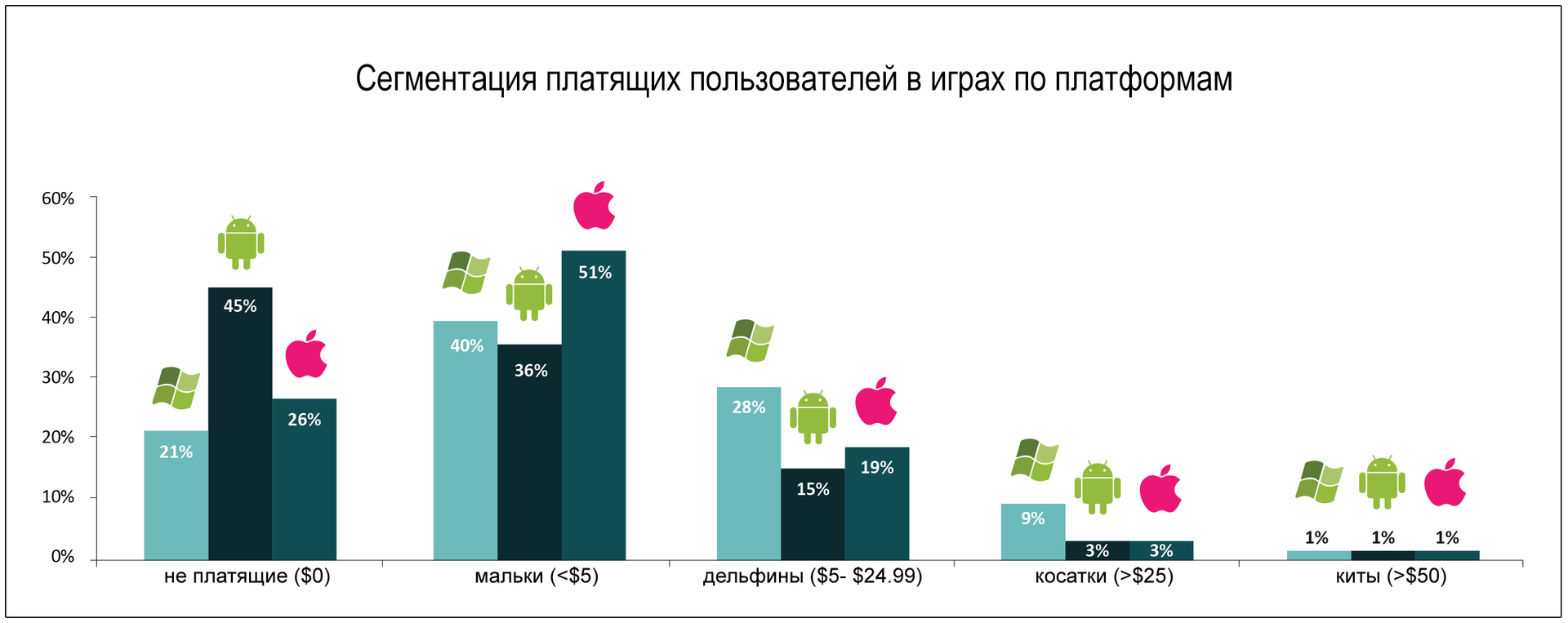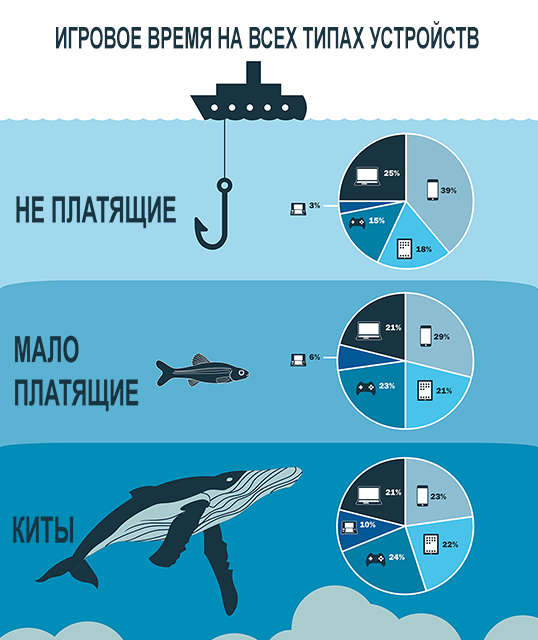For whom is this toy or how to determine the target audience
Many developers find it difficult to answer the question “for whom are you creating this?”. As polls and rich personal experience show, for the most part the answers to such questions sound too vague or even guesses.

First of all, you create a game for a specific target audience. If at the early stage of development you incorrectly defined your target audience, then the whole process will go along a curved road in the wrong direction. When the games do not live up to the expectations of the players, you can safely blame game designers who from the very beginning made a mistake in choosing the target audience or even scored this process.
With the heyday of the mobile market, the scale of the gaming audience has grown significantly, which has led to an even greater division of players into categories. Most often, players are divided into casual, midcore and hardcore.
You probably often hear such a characteristic of the players and you are no exception. Now it is almost the most popular and at the same time these are the most confusing terms in the gaming industry.

It’s time for many developers, and marketers alike, to recognize that they don’t quite understand the meaning of these concepts. Nevertheless, the developers reassure themselves that their superficial or erroneous knowledge should be enough, because this is at least some definition. In most cases, such vague concepts rather negatively affect the creation of a product than help make it perfect. It is even more confusing that some particularly intelligent individuals equate these concepts with a player’s skill. Casuals say noobs, and hardcore gamers. But what about the players who fit into all three categories and play radically different games?

With the advent of in-game purchases, players began to be divided by the level of financial capabilities.

I would like to dwell a little more on this issue. Let's try to revive the users.


The most famous problem today is the confidence of developers that their game is suitable for everyone. You can find many games that have gained popularity among game critics, but have not been able to bite off a large piece of the cake of popularity among players. A toy can be made wonderfully arbitrarily, only for whom? The conclusion that suggests itself is that everyone can play your game, but it’s not at all necessary that everyone will like it. “My game will suit absolutely all types of players” - a phrase that gives absolutely no useful information in terms of making the right design decisions.

But how to make decisions that directly affect the player’s experience, without understanding for whom do you actually make them? To solve this problem, you need to address the needs of users. Over the past 20 years, one tool has been used effectively in the software development industry. His name is PERSONS.
Software design pioneer and programmer Alan Cooper has always sought to get an easy-to-use product as an output. He was shaking at the mere thought that users would find his software too complicated and confusing.
At that time, when creating software, we first of all thought about technical efficiency. Alan realized that in order to get suitable software you need to break this template and begin to take into account the needs of users. It so happened that at first he asked potential users what they want, and then he started design. As a result, after endless interviews and tons of information gathered, he divided users into groups with similar meanings. He called each group - PERSON * name of person *.

Cooper realized that PERSONS are the perfect tool for creating truly user-friendly software. Having such volumes of information on hand, you can roll mountains. It became clear what functions users need, why they want them, in what form to present them, the difficulties they may encounter. It is necessary to evaluate the effectiveness of decisions in relation to each person, and then it will be clear which of them is closest to the concept of “our target audience”.
Now designers do not need to make subjective decisions and doubt their correctness. Thanks to the collected and verified data, we get undeniable facts. You can forget about team holivars, because we rely on statistically objective information received from our potential users.
Persons are quite helpful in restricting the flow of fantasy of the project team. If we reason from the point of view of the benefits of each idea for a particular person, we get rid of the mass of headaches and spam in the process of generating ideas.
Our key person’s guys have little free time to play, maybe we won’t show a 5 minute trailer every time we enter the game?
Creating people is a very time-consuming process. Do not try to fool yourself - collect data from real people, and do not invent it yourself.

The devil is not so terrible as he is painted. You already understood about the most complex and laborious process - interviewing potential users to create people. But there are ways to achieve a good result easier. One such way is to analyze existing data. Another way is to monitor players who are similar to your target audience. See if they play your game as you expected. The only drawback is that to work with analytics or to monitor players, you need a more or less working product.
If you still think that your game is suitable for everyone, try adding a few extreme people who will make you doubt. What if the user had not played games at all before, could he play your game? But what if he is blind or deaf? Try now to evaluate the availability of your game.
Playtest - testing a product by real users similar to your target audience with receiving feedback. Allows you to adequately look at your product from the side and fix the jambs at the initial stage of development. Another advantage of people - you know exactly who you need to attract for playtesting. If people are allowed to playtest inappropriate for your people, then what design solutions can you rely on in the end?
Let's look at the situation that you conducted a playtest and included 3 people in it, each person consisted of ten people similar to your target audience. As a result, you realized that two people used your product as expected and made useful comments, while the third person was radically different from your expectations. Now you can decide - modify the product to satisfy all 3 people or throw out the excess and focus on two people. In any case, you will have real evidence of any of your actions.
1. Demographic data.
- place of residence
- gender
- what kind of education
- income level
- family size
- what are the needs
2. Lifestyle.
- income level
- how they decide to spend their money
- squanders or conservatives
3. Interests.
- how to spend free time
- having a hobby
- preferences in sports
4. Influence.
- independent or subject to influence
- on the basis of which it makes decisions
5. Personal goals.
- what they want to achieve in life
- what needs are not sufficiently satisfied
6. Emotions.
- reaction to positive events
- reaction to negative events
7. Behavior.
- How and when they are willing to spend money
- What does this have to do with my project
- Relation to discounts
8. What do they want from your project.
- do they need a tutorial
- do they need additional services
- need to communicate with other players
For more than 20 years, creating people has been an effective working tool in software development, I think it’s not difficult to adapt it to games. After all, they will help not only make the right design decisions and understand the whole team for whom they are creating the game, but also significantly reduce the marketing budget. Your task is to attract only those who are really interested in your product, those who will pay and will be quite active.
You should be ashamed if, after reading this article, you will not create persons. Obviously, this will help make your product better, reduce development time and reduce the risk of failing in such a competitive market.

First of all, you create a game for a specific target audience. If at the early stage of development you incorrectly defined your target audience, then the whole process will go along a curved road in the wrong direction. When the games do not live up to the expectations of the players, you can safely blame game designers who from the very beginning made a mistake in choosing the target audience or even scored this process.
With the heyday of the mobile market, the scale of the gaming audience has grown significantly, which has led to an even greater division of players into categories. Most often, players are divided into casual, midcore and hardcore.
You probably often hear such a characteristic of the players and you are no exception. Now it is almost the most popular and at the same time these are the most confusing terms in the gaming industry.

It’s time for many developers, and marketers alike, to recognize that they don’t quite understand the meaning of these concepts. Nevertheless, the developers reassure themselves that their superficial or erroneous knowledge should be enough, because this is at least some definition. In most cases, such vague concepts rather negatively affect the creation of a product than help make it perfect. It is even more confusing that some particularly intelligent individuals equate these concepts with a player’s skill. Casuals say noobs, and hardcore gamers. But what about the players who fit into all three categories and play radically different games?
With the advent of in-game purchases, players began to be divided by the level of financial capabilities.

I would like to dwell a little more on this issue. Let's try to revive the users.

The most famous problem today is the confidence of developers that their game is suitable for everyone. You can find many games that have gained popularity among game critics, but have not been able to bite off a large piece of the cake of popularity among players. A toy can be made wonderfully arbitrarily, only for whom? The conclusion that suggests itself is that everyone can play your game, but it’s not at all necessary that everyone will like it. “My game will suit absolutely all types of players” - a phrase that gives absolutely no useful information in terms of making the right design decisions.
Persons
But how to make decisions that directly affect the player’s experience, without understanding for whom do you actually make them? To solve this problem, you need to address the needs of users. Over the past 20 years, one tool has been used effectively in the software development industry. His name is PERSONS.
Software design pioneer and programmer Alan Cooper has always sought to get an easy-to-use product as an output. He was shaking at the mere thought that users would find his software too complicated and confusing.
At that time, when creating software, we first of all thought about technical efficiency. Alan realized that in order to get suitable software you need to break this template and begin to take into account the needs of users. It so happened that at first he asked potential users what they want, and then he started design. As a result, after endless interviews and tons of information gathered, he divided users into groups with similar meanings. He called each group - PERSON * name of person *.

Cooper realized that PERSONS are the perfect tool for creating truly user-friendly software. Having such volumes of information on hand, you can roll mountains. It became clear what functions users need, why they want them, in what form to present them, the difficulties they may encounter. It is necessary to evaluate the effectiveness of decisions in relation to each person, and then it will be clear which of them is closest to the concept of “our target audience”.
Now designers do not need to make subjective decisions and doubt their correctness. Thanks to the collected and verified data, we get undeniable facts. You can forget about team holivars, because we rely on statistically objective information received from our potential users.
Persons are quite helpful in restricting the flow of fantasy of the project team. If we reason from the point of view of the benefits of each idea for a particular person, we get rid of the mass of headaches and spam in the process of generating ideas.
Our key person’s guys have little free time to play, maybe we won’t show a 5 minute trailer every time we enter the game?
Creating people is a very time-consuming process. Do not try to fool yourself - collect data from real people, and do not invent it yourself.

The devil is not so terrible as he is painted. You already understood about the most complex and laborious process - interviewing potential users to create people. But there are ways to achieve a good result easier. One such way is to analyze existing data. Another way is to monitor players who are similar to your target audience. See if they play your game as you expected. The only drawback is that to work with analytics or to monitor players, you need a more or less working product.
If you still think that your game is suitable for everyone, try adding a few extreme people who will make you doubt. What if the user had not played games at all before, could he play your game? But what if he is blind or deaf? Try now to evaluate the availability of your game.
Playtest - testing a product by real users similar to your target audience with receiving feedback. Allows you to adequately look at your product from the side and fix the jambs at the initial stage of development. Another advantage of people - you know exactly who you need to attract for playtesting. If people are allowed to playtest inappropriate for your people, then what design solutions can you rely on in the end?
Let's look at the situation that you conducted a playtest and included 3 people in it, each person consisted of ten people similar to your target audience. As a result, you realized that two people used your product as expected and made useful comments, while the third person was radically different from your expectations. Now you can decide - modify the product to satisfy all 3 people or throw out the excess and focus on two people. In any case, you will have real evidence of any of your actions.
Person Creation Example
1. Demographic data.
- place of residence
- gender
- what kind of education
- income level
- family size
- what are the needs
2. Lifestyle.
- income level
- how they decide to spend their money
- squanders or conservatives
3. Interests.
- how to spend free time
- having a hobby
- preferences in sports
4. Influence.
- independent or subject to influence
- on the basis of which it makes decisions
5. Personal goals.
- what they want to achieve in life
- what needs are not sufficiently satisfied
6. Emotions.
- reaction to positive events
- reaction to negative events
7. Behavior.
- How and when they are willing to spend money
- What does this have to do with my project
- Relation to discounts
8. What do they want from your project.
- do they need a tutorial
- do they need additional services
- need to communicate with other players
...............
Conclusion
For more than 20 years, creating people has been an effective working tool in software development, I think it’s not difficult to adapt it to games. After all, they will help not only make the right design decisions and understand the whole team for whom they are creating the game, but also significantly reduce the marketing budget. Your task is to attract only those who are really interested in your product, those who will pay and will be quite active.
You should be ashamed if, after reading this article, you will not create persons. Obviously, this will help make your product better, reduce development time and reduce the risk of failing in such a competitive market.
Only registered users can participate in the survey. Please come in.
What to write about next time?
- 19.9% How to avoid visual confusion in games (translation) 86
- 17.8% Mobile game design. Iterations VS Planning (Translation) 77
- 19% What you need in games to win. Skill VS luck (translation) 82
- 16% Predictions in the gaming industry (translation) 69
- 10.9% Experiments with motivation or how to become effective in life (own experience) 47
- 16.2% I do not care, it is interesting to know the results 70
